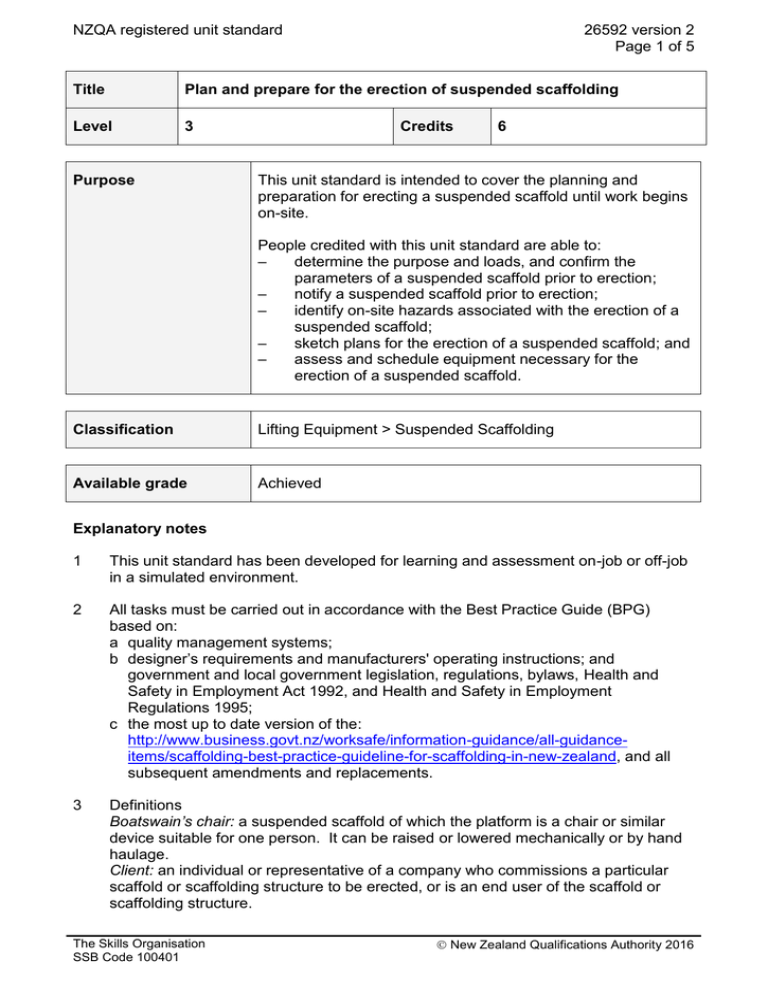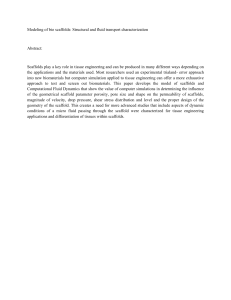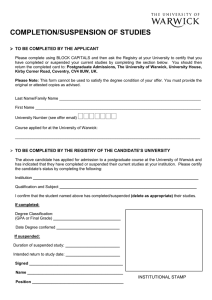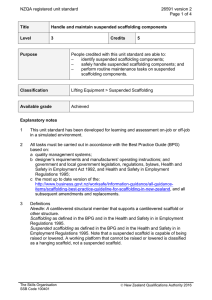NZQA registered unit standard 26592 version 2 Page 1 of 5
advertisement

NZQA registered unit standard 26592 version 2 Page 1 of 5 Title Plan and prepare for the erection of suspended scaffolding Level 3 Purpose Credits 6 This unit standard is intended to cover the planning and preparation for erecting a suspended scaffold until work begins on-site. People credited with this unit standard are able to: – determine the purpose and loads, and confirm the parameters of a suspended scaffold prior to erection; – notify a suspended scaffold prior to erection; – identify on-site hazards associated with the erection of a suspended scaffold; – sketch plans for the erection of a suspended scaffold; and – assess and schedule equipment necessary for the erection of a suspended scaffold. Classification Lifting Equipment > Suspended Scaffolding Available grade Achieved Explanatory notes 1 This unit standard has been developed for learning and assessment on-job or off-job in a simulated environment. 2 All tasks must be carried out in accordance with the Best Practice Guide (BPG) based on: a quality management systems; b designer’s requirements and manufacturers' operating instructions; and government and local government legislation, regulations, bylaws, Health and Safety in Employment Act 1992, and Health and Safety in Employment Regulations 1995; c the most up to date version of the: http://www.business.govt.nz/worksafe/information-guidance/all-guidanceitems/scaffolding-best-practice-guideline-for-scaffolding-in-new-zealand, and all subsequent amendments and replacements. 3 Definitions Boatswain’s chair: a suspended scaffold of which the platform is a chair or similar device suitable for one person. It can be raised or lowered mechanically or by hand haulage. Client: an individual or representative of a company who commissions a particular scaffold or scaffolding structure to be erected, or is an end user of the scaffold or scaffolding structure. The Skills Organisation SSB Code 100401 New Zealand Qualifications Authority 2016 NZQA registered unit standard 26592 version 2 Page 2 of 5 Parapet hook: a clamp or bracket placed over a parapet from which a scaffold is suspended. Proprietary needle: a pre-engineered cantilevered structural member that supports a scaffold. Suspended scaffolding as defined in the BPG and additionally in the Health and Safety in Employment Regulations 1995. Note that a suspended scaffold is capable of being raised or lowered. A working platform that cannot be raised or lowered is classified as a hanging scaffold, not a suspended scaffold. Swinging stage: a suspended scaffold platform that can be raised or lowered. Company requirements: include the policy, procedures, and methodologies of the company. They include legislative and regulatory requirements which may apply across the company or to a specific site. Requirements are documented in the company’s health and safety plans, contract work programmes, quality assurance programmes, policies, and procedural documents. 4 Assessment This unit standard must be assessed against using proprietary suspended scaffolding systems and components. Evidence is required for at least two suspended scaffolds, at least one boatswain’s chair and one swinging stage. Also, candidates must be assessed for scaffolds suspended from both proprietary needles and parapet hooks. Outcomes and evidence requirements Outcome 1 Determine the purpose and loads, and confirm the parameters of suspended scaffolds prior to erection. Evidence requirements 1.1 Determine the purpose of the suspended scaffolds. Range 1.2 Determine the loads of the suspended scaffolds. Range 1.3 may include but is not limited to – plans, consultation with supervisor, consultation with client. may include but is not limited to – dead weight of the stage or boatswain’s chair, ropes, people, materials and/or tools, live load. Confirm the parameters of the suspended scaffolds on-site. Range includes but is not limited to – the area to be accessed, height and number of drop(s), suspension points. Outcome 2 Notify a suspended scaffold prior to erection. Range includes – WorkSafe NZ, completion of legal requirements; may also include but is not limited to – local authority, electricity authorities, completion of workplace procedures. The Skills Organisation SSB Code 100401 New Zealand Qualifications Authority 2016 NZQA registered unit standard 26592 version 2 Page 3 of 5 Evidence requirements 2.1 Notify the suspended scaffold prior to erection. Outcome 3 Identify on-site hazards associated with the erection of suspended scaffolds. Evidence requirements 3.1 Identify on-site hazards. Range 3.2 may include but is not limited to – power lines, power leads, site entry points, site exit points, traffic, other activities being conducted, fire risk, weather conditions. Complete required workplace safety documentation in relation to the suspended scaffolds. Range may include but is not limited to – traffic management plan, geardrop site sketch, height safety considerations. Outcome 4 Sketch plans for the erection of suspended scaffolds. Evidence requirements 4.1 Draw plans of the suspended scaffolds in the context of the site on which the suspended scaffold is to be erected. 4.2 Establish and sketch the optimum placement of the suspended scaffolds and associated components. Range may include but is not limited to – consideration of access issues, job requirements, counterweight and bracing positions, viable parapet hook or proprietary needle attachment points. 4.3 Show where proprietary needles are used to suspend scaffolding, counterweight calculations and placement on the plan. 4.4 Where parapet hooks are used, check the integrity of the parapet with a registered engineer, or another scaffolder holding the appropriately endorsed certificate of competence. Outcome 5 Assess and schedule equipment necessary for the erection of suspended scaffolds. The Skills Organisation SSB Code 100401 New Zealand Qualifications Authority 2016 NZQA registered unit standard 26592 version 2 Page 4 of 5 Evidence requirements 5.1 Compile an equipment list for the erection of the suspended scaffolds. 5.2 Schedule equipment for the erection of the suspended scaffolds. 5.3 Compile a loading priority list for the erection of the suspended scaffolds 5.4 Schedule transport to move equipment to the scaffold site. Replacement information Planned review date This unit standard, unit standard 26591, unit standard 26593, and unit standard 26594 replaced unit standard 4204, unit standard 4205, and unit standard 4207. 31 December 2019 Status information and last date for assessment for superseded versions Process Version Date Last Date for Assessment Registration 1 21 July 2011 31 December 2016 Review 2 16 July 2015 N/A Consent and Moderation Requirements (CMR) reference 0003 This CMR can be accessed at http://www.nzqa.govt.nz/framework/search/index.do. Please note Providers must be granted consent to assess against standards (accredited) by NZQA, before they can report credits from assessment against unit standards or deliver courses of study leading to that assessment. Industry Training Organisations must be granted consent to assess against standards by NZQA before they can register credits from assessment against unit standards. Providers and Industry Training Organisations, which have been granted consent and which are assessing against unit standards must engage with the moderation system that applies to those standards. Requirements for consent to assess and an outline of the moderation system that applies to this standard are outlined in the Consent and Moderation Requirements (CMRs). The CMR also includes useful information about special requirements for organisations wishing to develop education and training programmes, such as minimum qualifications for tutors and assessors, and special resource requirements. The Skills Organisation SSB Code 100401 New Zealand Qualifications Authority 2016 NZQA registered unit standard 26592 version 2 Page 5 of 5 Comments on this unit standard Please contact The Skills Organisation at reviewcomments@skills.org.nz if you wish to suggest changes to the content of this unit standard. The Skills Organisation SSB Code 100401 New Zealand Qualifications Authority 2016



